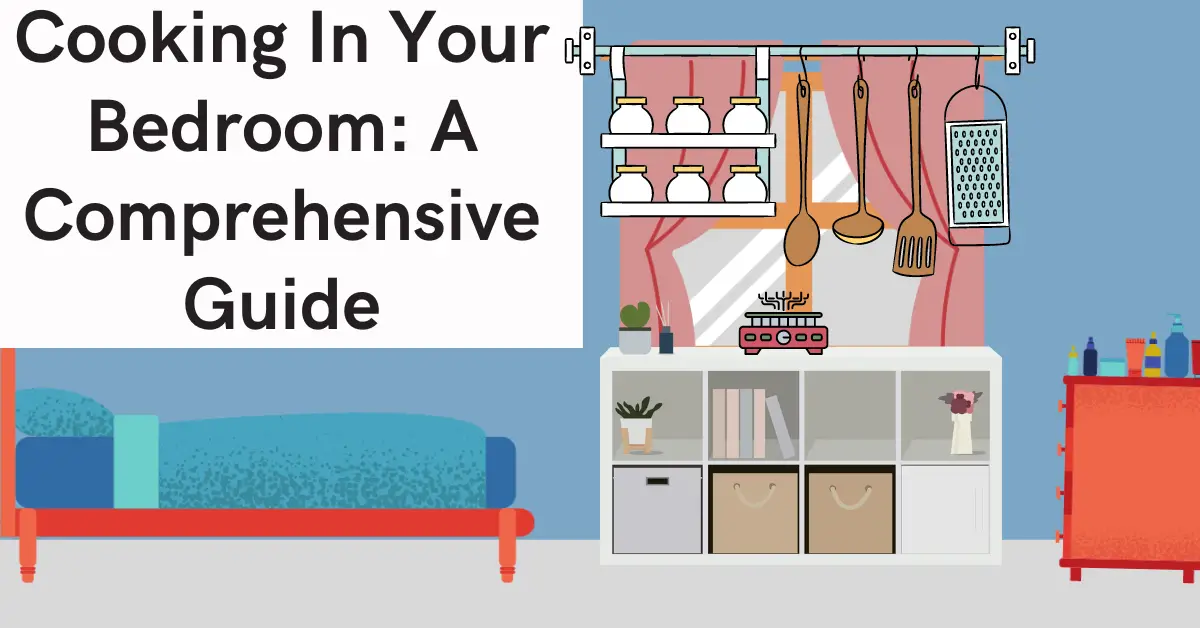I am a well-rounded expert with proficiency in several fields. My experience spans from being a dedicated chef and homemaker. As a passionate homesteader, I’ve honed my skills in sustainable living and animal care, ensuring a holistic approach to everything I undertake. Email me or Txt: (# removed due to spam, please email)
In recent years, the trend of cooking in bedrooms has gained popularity for various reasons, including space constraints and personal preferences.
This comprehensive guide explores the benefits, drawbacks, and safety concerns associated with cooking in your bedroom, as well as tips and recommendations for creating a functional and safe mini kitchen.

Pros and Cons of Cooking in Your Bedroom
| Pros and Cons of Cooking in Your Bedroom | Pros | Cons |
|---|---|---|
| Convenience | ||
| – Limited access to a kitchen | ✓ | |
| – Compact kitchen setup | ✓ | |
| – Time and energy savings | ✓ | |
| Privacy | ||
| – Personal comfort | ✓ | |
| – Avoiding crowded communal kitchens | ✓ | |
| Health and Safety Risks | ||
| – Poor ventilation | ✓ | |
| – Improper food storage | ✓ | |
| – Proximity to flammable materials | ✓ | |
| – Potential accidents | ✓ | |
| Odor and Air Quality Concerns | ||
| – Lingering smells | ✓ | |
| – Decreased indoor air quality | ✓ | |
| – Respiratory issues | ✓ | |
| – Other health problems | ✓ |
Benefits
Convenience
For individuals with limited access to a kitchen or those who prefer to keep their culinary endeavors private, cooking in the bedroom can be an attractive solution. Having a compact kitchen setup within your personal space can save time and energy.
Privacy
Some people may feel more comfortable preparing their meals in the privacy of their bedroom, especially in shared living situations where communal kitchens can be crowded and chaotic.
Drawbacks
Health and Safety Risks
Cooking in the bedroom can pose potential risks to your health and safety. Poor ventilation, improper food storage, and close proximity to flammable materials can create hazardous conditions.
Odor and Air Quality Concerns
The smells and fumes produced by cooking can linger in your bedroom, negatively impacting your comfort and indoor air quality. This may lead to respiratory issues and other health problems over time.

Setting Up a Mini Kitchen in Your Bedroom
Essential Equipment
To create a functional and safe mini kitchen, invest in compact appliances such as a mini-fridge, microwave, electric kettle, and an induction cooktop. Make sure to choose appliances with safety features and energy-efficient designs.
Space-saving Solutions
Utilize vertical storage solutions like shelves and hanging racks to maximize space. Consider foldable or multi-purpose furniture to maintain a clutter-free environment.
Maintaining Cleanliness and Hygiene
Regular cleaning and sanitizing of your cooking area is crucial to prevent foodborne illnesses and maintain a healthy environment. Establish a cleaning routine that includes wiping down surfaces, washing dishes and utensils promptly, and properly disposing of food waste.

Cooking Pot Selection for Your Bedroom
When it comes to selecting cooking pots for your bedroom, there are several factors to consider to ensure both safety and convenience. Here are some tips to keep in mind:
Electric Appliances
Opt for electric appliances: Electric cooking appliances such as slow cookers, rice cookers, and electric skillets are generally safer and more energy-efficient than traditional stovetops.
They also offer more precise temperature control, making it easier to cook your meals to perfection.
Safe and Compact Options
Choose safe and compact options: Look for pots and pans with non-stick coatings and heat-resistant handles to minimize the risk of accidents.
In addition, consider compact and stackable designs to save space and simplify storage.
Pros and Cons of Different Materials
| Cookware Material | Pros | Cons |
|---|---|---|
| Aluminum | Lightweight; Heats up quickly | Reacts with acidic foods |
| Stainless Steel | Durable; Easy to maintain | Poor heat conductivity |
| Cast Iron | Excellent heat retention; Durable | Heavy; Requires seasoning |
| Ceramic | Non-reactive; Heats evenly | Fragile |
When selecting cooking pots for your bedroom, it’s important to consider the different materials available and their respective pros and cons. Here’s a breakdown of the most common cookware materials:
- Aluminum: Aluminum is a lightweight and affordable option that heats up quickly and evenly. However, it can react with acidic foods, which can alter the taste and appearance of your meals.
- Stainless Steel: Stainless steel is a popular choice for its durability and easy maintenance. It’s also non-reactive, meaning it won’t interact with acidic foods or alter the taste of your meals. However, it doesn’t conduct heat as well as other materials, which can lead to uneven cooking.
- Cast Iron: Cast iron is known for its excellent heat retention and durability. It’s also a great choice for high-heat cooking and can be used on a variety of cooking surfaces. However, it can be heavy and require seasoning to maintain its non-stick properties.
- Ceramic: Ceramic cookware is a non-reactive option that heats evenly and retains heat well. It’s also an attractive option that can be used for serving. However, it can be fragile and may crack or chip if dropped.
When selecting cooking pots for your bedroom, it’s important to consider the materials available and their respective pros and cons.
By selecting the right material for your needs and preferences, you can ensure a safe and enjoyable cooking experience in your bedroom.

Air Pollution and Indoor Air Quality
Sources of Indoor Air Pollution from Cooking
Cooking can release various air pollutants, such as fine particles, volatile organic compounds (VOCs), and nitrogen dioxide. These can have detrimental effects on your health if not properly managed.
Effects on Health and Well-being
Prolonged exposure to indoor air pollutants may lead to respiratory issues, allergies, and other health problems. Inflamed or irritated lungs can be especially bad in a bedroom from sodium smoke, Aka bacon. This is especially dangerous if you are allergic.
Ensuring proper ventilation and air purification is essential to minimize these risks.
Strategies to Mitigate Air Pollution
Invest in a high-quality air purifier to reduce pollutants, and make sure your bedroom has adequate ventilation. Limit the use of high-emission cooking methods, like frying or grilling, to minimize air pollution.
If possible, consider sticking a box fan facing outwards in an open window (Securely so it doesn’t fall out!).

What to Never Cook in the Bedroom
Deep-frying and Open Flame Cooking
Avoid deep-frying and open flame cooking methods, such as gas stoves or charcoal grills, as they pose a significant fire hazard, burn hazard and produce excessive amounts of smoke and fumes.
Foods with Strong Odors
Steer clear of cooking foods with strong odors, such as fish or garlic, as they can permeate fabrics and linger in your bedroom for extended periods.
Highly Perishable Items
Refrain from preparing highly perishable items, like raw meat or dairy products, without proper storage and refrigeration facilities to reduce the risk of foodborne illnesses.

Dangers of Cooking Near Flammable Objects
Common Bedroom Hazards
Bedding, curtains, carpets, and clothing are all flammable materials commonly found in bedrooms. Cooking near these items increases the risk of fires and accidents.
There is a reason you will never see fabrics in the kitchen aside from maybe a window curtain. They pick up stains, food smells and they are extremely flammable. As they absorb grease they become almost like candles.
Fire Prevention and Safety Tips
Keep a fire extinguisher and smoke alarm in your bedroom, and ensure that they are regularly maintained and functional. Maintain a safe distance between your cooking area and flammable materials, and never leave your cooking appliances unattended.
It’s never a bad idea to have a carbon monoxide (CO) detector as well! It’s an invisible killer.
Emergency Preparedness
Familiarize yourself with fire escape routes and establish an emergency plan in case of accidents. Share this plan with other occupants of your living space to ensure everyone’s safety.

Cooking Safety Tips for Bedroom Chefs
Proper Ventilation
Ensure adequate ventilation by opening windows or using an exhaust fan while cooking to prevent the buildup of harmful pollutants and lingering odors.
Food Storage and Handling
Store perishable items in a mini-fridge and use proper food handling techniques, such as washing your hands and separating raw and cooked foods, to minimize the risk of contamination.
Electrical Safety
Avoid overloading electrical outlets and use surge protectors to prevent electrical fires. Inspect your appliances regularly for frayed cords or other signs of wear.

Healthy and Easy Bedroom Recipes
No-cook and Microwave-friendly Dishes
Prepare simple and nutritious no-cook meals, like salads and wraps, or microwave-friendly dishes, such as steamed vegetables and grains, to minimize the need for extensive cooking.
One-pot Meal Ideas
Experiment with one-pot recipes, like soups, stews, or stir-fries, to reduce cleanup and simplify your cooking process.
Nutritious Snack Options
Keep a variety of healthy snacks, like nuts, fruits, and yogurt, on hand to curb your hunger between meals without resorting to unhealthy or complicated dishes.

Cleaning and Maintenance Tips
Daily Cleaning Routines
Establish a daily cleaning routine that includes wiping down surfaces, washing dishes and utensils, and properly disposing of food waste.
Dealing with Spills and Stains
Address spills and stains immediately to prevent long-lasting damage to your bedroom’s furnishings and fabrics.
Odor Management Strategies
Use air fresheners or scented candles to combat lingering odors, and regularly wash your bedding and curtains to keep your bedroom smelling fresh.
Don’t put food scraps or waste in the bedroom garbage, Or if you have no choice, Remove it daily. Food’s go bad quickly and can start to smell pretty bad.
Fruit scraps also cause infestations of bugs like fruit flies which you definitely don’t want in your bedroom!

Legal and Ethical Considerations
Rental Agreements and Housing Policies
Check your rental agreement and local housing regulations to ensure that cooking in your bedroom is permitted, as it may be prohibited due to fire safety concerns.
If you are in a dorm, Check the dorm rules first.
Neighborhood Rules and Regulations
Adhere to any neighborhood or building-specific rules regarding cooking and food preparation to maintain good relationships with your neighbors and community.
Conclusion
While cooking in your bedroom can provide convenience and privacy, it is crucial to weigh the benefits against the potential health and safety risks.
By following best practices and prioritizing safety, you can create a functional and enjoyable bedroom kitchen experience.



